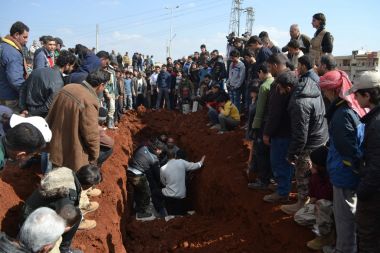US Syria strategy in peril with collapse of CIA-backed rebel group

The Hazzm movement was once central to a covert CIA operation to arm Syrian rebels, but the group's collapse last week underlines the failure of efforts to unify Arab and Western support for mainstream insurgents fighting the Syrian military.
A blow to US moves to aid rebels, the dissolution of Hazzm also highlights the risks that a new Department of Defense program could face in training and equipping fighters in Jordan, Turkey and Qatar.
US officials plan to train thousands of Syrian rebels over three years. The program is expected to begin this month in Jordan and focuses on battling the hardline Islamic State group rather than President Bashar al-Assad.
Hazzm's collapse has shown how such efforts will prove difficult in a country where insurgents often battle each other and arms have fallen into the hands of hardline groups.
An onslaught by al Qaeda's Syria wing, the Nusra Front, last week forced Hazzm into dissolution, its members swallowed by Jabhat al-Shamiyya, a mainly Islamist alliance. It was the second time in four months that Nusra had crushed a Western-backed rebel group.
Nusra is now considering cutting its ties with al Qaeda in a rebranding exercise backed by Qatar and some other Gulf states that will bring in more funds, sources say.
On Tuesday, Nusra followers published photographs on Twitter of what they said were US weapons, including anti-tank missiles, seized in battles with opposition brigades.
Reuters could not authenticate the photographs but the head of the Syrian Observatory for Human Rights, Rami Abdulrahman, said many arms had been seized, including 60 to 90 TOW anti-tank missiles.
Hazzm members did not respond to requests for comment or were not reachable. The group once claimed to be the main recipient of the secret US-led operation supporting rebels in the north. It numbered 1,200-1,500 last year, Abdulrahman said.
It was set up in January 2014 and came under a body known as MOM, which was used to funnel resources to rebels in an attempt to coordinate funding. Money has poured into northern Syria from Gulf Arab states including Saudi Arabia and Qatar, much of it going to Islamist fighters, including hardliners.
"The United States was never particularly serious in its support for the MOM, and coordination among the United States and other state backers broke down," said Noah Bonsey, a senior Syria analyst at the International Crisis Group.
"The defeat of Hazzm is the latest indication of the MOM's failure in the north," he said.
State Department spokeswoman Marie Harf said Hazzm had received non-lethal U.S. assistance. Washington has never acknowledged the CIA program.
The group's demise "will have an impact on the moderate opposition's capabilities in the north," Harf said.
The group had shrunk to about 400 fighters last month after killings, desertions and arrests, the Observatory's Abdulrahman said. "They are now finished, like sugar in tea."
FAVOURITE SON
Almost a year ago, US anti-tank weapons appeared in YouTube videos showing the formation of Hazzm. Opposition members said they hoped the group would form a new non-jihadist rebel structure after groups had lost non-lethal aid to Islamist groups.
Hazzm officials received visitors at an office in the Turkish town of Reyhanli, where they briefed on their pluralistic vision for Syria while handing out Hazzm business cards and predicting more military support.
Some in the group regretted the images of Hazzm fighters with the anti-tank missiles, saying they annoyed other brigades. The US-led program spread to other rebels but Hazzm received the most, fuelling resentment.
"Everyone hated Hazzm," said a Syrian consultant working with rebel brigades who did not want to be named. "Imagine if there is a father and he has a favourite son. Everything is given to him ... the other son starts to hate the father and the favourite son."
"Hazzm got everything – TOWs, training camps with everything like hospitals." When Nusra attacked Hazzm, no other groups came to its rescue, he said.
Another rebel said Hazzm had been "built" for the US-led effort to control the flow of aid into northern Syria.
Hazzm leaders complained the US program, which included weapons and some salaries for fighters, would make little difference in their fight against both the army and jihadists.
In October and November, Nusra took over Idlib, once a stronghold of more secular rebels, annihilating another once powerful brigade which previously received US aid, the Syrian Revolutionaries Front, and forcing its leader Jamal Maarouf into hiding in Turkey.
There were efforts to keep track of the weapons provided in the program. Hazzm and other groups had to film the use of every anti-tank missile, and return the casings. But heavy weapons ended up with Nusra last year, opposition sources say.
In response, the US reduced support and stopped inviting group leaders to the secret meetings with intelligence representatives where allocations were decided.
With Idlib mostly under Nusra control the United States stopped sending weapons there, a rebel source said.
Hazzm aligned itself with Jabhat al-Shamiyyah this year to fight Nusra. But the alliance did not save Hazzm.
"Hazzm failed because it could not convince the people of its ideological project," said the head of a mainstream rebel group in Syria, speaking via the internet. "Nusra harvested its mistakes."











